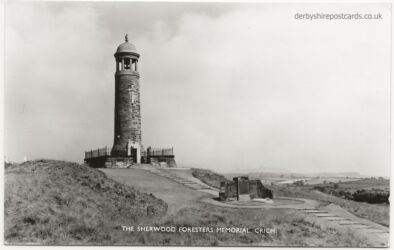Crich Stand
from the on-site info board – THE SITE
The memorial on Crich Hill can be seen from the counties from which the men who died were mainly drawn – by night the flashing light in the tower would act as the reminder.
ANNUAL REGIMENTAL PILGRIMAGES
Each year since 1923 the Regiment has held a Pilgrimage and a Service of Commemoration here for those who died in Service. It is held on the first Sunday in July.
INDIVIDUAL MEMORIALS
In addition to the Memorial Tower there are three memorials to individual members who are remembered for their outstanding contributions to the Regiment.
General Sir Horace L Smlth-Dorrien GCB GCMG DSO
(died 12 August 1930)
Colonel of The Sherwood Foresters 1905-1930. As Commander D Corps of the British Expeditionary Force in the First World War, he decided, contrary to orders, to stand and fight at Le Cateau, France on 26 August 1914 during the British Army’s retreat from Mons thus saving the Army from destruction by the advancing German forces.
Brigadier J H M Hackett DSO OBE
(died 19 February 1985)
Last colonel of the Sherwood Foresters, 1965-1969 and the first colonel ot The Worcestershire and Sherwood Foresters Regiment 1970-1972.
Colonel SLA Carter OBE MC
(died 4 August 1999)
President the Sherwood Foresters Association 1977-1985.
TOWER FACTS
Height 63 feet (19m). Base 955 feet (291m) above sea level. 59 steps to the gallery beneath the dome. Dome weighs 40 tons. Land donated by Francis Hurt. Built 1923 by Joseph Payne of Crich Cost £1182. 8s 5d Stones from the demolished 1851 Stand. One stone from the 1788 tower is included, it can be sseen on the left hand side.
Architect was Lt Col A W Brewill DSO commander of the 1st/7th (Robin Hood) Battalion of the Sherwood Foresters during the First World War.
THE BEACON
The hill may have been part of the beacon chain used in 1588 to warn of the approaching Spanish Armada. A beacon was lit in 1988 on the 400th Anniversary of the defeat of the Armada.
On 1 January 2000 the beacon was lit for the start of the new millennium.
It was also lit on 4 August 2000 to celebrate Queen Elizabeth, The Queen Mother’s hundredth birthday
The present stone beacon was built by Crich Parish Council and first fit on 3 June 3002 to
celebrate Queen Elizabeth 0’s Golden Jubilee.
CRICH HILL
‘Crich’ comes from the ancient British word ‘cruc’ meaning hill’.
Items from Roman occupation have been found on the hill and there may have been lead mining then.
The Domesday Book in 1086 records lead mining and it was certainly carried out in the 17th, 18th and 19th centuries.
The hill is a carboniferous limestone outcrop. Hence in the early 18* century there were a number of
kilns on the hill to produce lime. Quarrying resulted in the disappearance of most of the hill.



